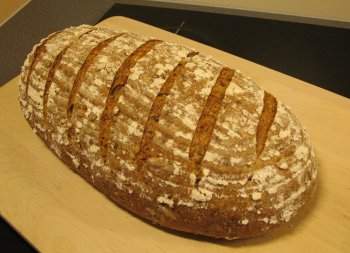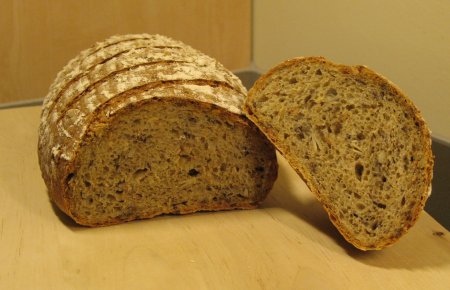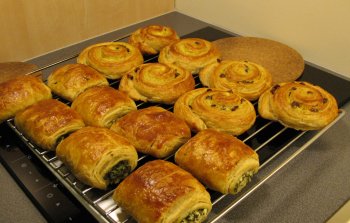I've seen Hamelman's five-grain rye sourdough bread recommended a couple of times, but it wasn't until this morning that I had the opportunity to bake it for myself. It's a modest 25% whole rye, but the loaf is also studded with seeds and cracked rye, and there's a lot of flavor in it.

No easily obtainable "high-gluten flour" around these parts, so I used my regular flour, but made sure the dough was strong and well-developed before bulk fermentation. It looked delicious even at that stage: A nice brown ball, flecked with dark flaxseeds and cracked rye. The rye sour infuses each slice with great taste, and the soaker and the high hydration keeps the crumb ultra moist and tender.

So, when breakfast's over, and you pour yourself a cup of black coffee, what better way to finish off your meal than with some Viennoserie? Last week I made a batch of croissant dough, using some prefermented dough and putting 20% whole wheat flour into the mix. Half of the dough was rolled around spinach and feta cheese filling, and the other half was brushed with pastry cream and sprinkled with raisins. Yum!

- hansjoakim's Blog
- Log in or register to post comments
You certainly did get a well developed dough in the 5 grain. Very nice shape. That's one of my favorite breads out of that book. It's such a deep wholesome flavor. I have been a lot happier with it since I started soaking the flax seeds with the grain mix.
Around these parts they call your spinach/feta in puff pastry, Spanikopita. I had some for breakfast yesterday at a local Greek restaurant I go to all the time. I'm convinced the family restaurant version is better than the one I make at home because of the better grade of feta they use. You no doubt have pretty good cheese, everywhere.
Great post Hansjoakim. I enjoy your creativity.
Eric
Your baking is truly inspiring! I really enjoy making laminated doughs, but never thought to fill them with spinach & feta. What a great idea.
--Pamela
Hi Eric and Pamela, and thanks for your posts :)
I agree, spinach and feta is such a nice match. The white and green look great together, and it tastes sublime too! This kind of filling works well with this croissant dough where there's 20% whole wheat flour and it makes for a nice, savory snack.
Spanikopita, Eric? I'll have a look around in a local Greek food store - I'd love to sample some made with true authentic ingredients. The feta cheese I used is produced in Denmark, so no authentic Spanikopita in my joint, I'm afraid ;) Thanks for the tip!
And I agree about the multigrain loaf - Of the Hamelman multigrain loaves I've sampled, this is my favourite. The soaker and rye sour compliments each other very nicely.
Thanks again :)
Wow, beautiful output as usual from you, Hans! That rye is gorgeous with a nice open crumb. And I love croissant of any type, but especially pain au raisin.
Question, though: what is pastry cream? Is this formula from ABAP? Mine came in and now I need to find time to read up.
I'm a bit intimidated about making laminated dough, it seems like a lot of work compared to lean bread or even just a sweet dough cinnamon roll. When I was in 9th grade, my Dad made croissants from scratch for my French class - what a great Dad, it was a lot of work though as I recall!
Thanks, md!
Great to hear that you're all set up with ABAP now! It's a wonderful resource for most things bread and pastry.
You'll find a recipe for pastry cream in ABAP as well; it's a standard cream for many cakes (e.g. Napoleons and several tarts). You mix yolks and sugar with flour and cornstarch. Then you boil milk, pour some of the hot milk over the egg mix and stir. Then pour the egg mix into the pot with boiling milk. Stir continuously, and boil for two minutes. I think it's called "pastry cream" or "Crème Patisserie".
Laminated dough is a lot of work! But you don't have to make up every single fold on one day. Between the folds, the dough needs to rest in the fridge, to not get overheated (excessive yeast activity, melting butter = *mess*) and to allow the gluten some time to relax. If you're doing three or four folds, you could do all but the last one during day 1, retard in the fridge overnight, then come back to do the final fold and makeup during day 2. The upside to this is that you'll get a more complex flavor. The downside, is that the dough might be trickier to work with, as it's probably more gassy on day 2. A lot of these considerations are discussed at length in part 3 of ABAP.
For me, the key to get a decent laminated dough, is to get the texture/pliability of the butter just right. From there on in, it's just nice therapy for me to sit at the table and roll out, fold, chill, roll out, fold chill... Thanks for your post, md, and I'm looking forward to read about your first ABAP loaves :)
I'm enjoying just reading the first chapter on the role of bread in the development of civilization! Since you describe making laminated dough as something that can be spaced out over a couple of days, that may be something I can get into after all. I look forward to getting to that chapter, and thanks for the info on pastry cream, sounds delicious...
Hi Jw,
Thanks! You've found the recipe for the loaf? The overall recipe is 25% whole rye flour and 75% "high-gluten flour". I don't have anything called "high-gluten flour" at my local stores, so I used my regular brand of wheat flour. I'm not sure what this is called in the US, perhaps it's "Bread flour" or "All-purpose flour"? It's basically wheat flour with an extraction rate of approx. 75-77% and an ash content of about 0.75.
...receiving an invitation to this little get-together of yours. I would've even volunteered to bring the coffee.
Everything looks great.
-Mark
http://TheBackHomeBakery.com
PS. I make my 'Schnecke' with a poppyseed paste mixture that I spread on (like you did your pastry cream) before the roll-up.
Wonderful looking rye, Hans. But I think I gained a couple pounds just looking at your Viennoserie.
I've been looking at the Hamelman five-grain sourdough with rye sourdough for about a week; just started a rye sourdough Monday and hope to be able to use it by Sunday. Am using Arrowhead organic rye and while it doubled the second day, this is my first 100% rye starter so I may let it go a bit longer.
The only high gluten flour I can find is through King Arthur and I'd prefer to wait until they have one of their free shipping sales before ordering it. I was thinking of adding a tablespoon of vital wheat gluten to my bread flour. Any thoughts about that?
Hi Mark and LindyD,
And thanks for your replies :)
Well, you know Mark, my house is always open for guests (at least when the bakes turn out alright)! I've got another rye waiting for the oven right now, and I think it'll keep fresh in the bread box for at least three or four days. Just so you know... ;) Oh, do bring some smelly cheese if you make it over here. I bought some herring from the store last night, but I forgot the cheese.
Lindy, if you're using organic rye, you're definitely on the right track. Still, I'd bet that it will take four to five days before the starter is mature enough for bread baking. The initial rise after 24 - 48 hours is due to other bacteria and not the yeast. Just keep feeding it, and the right balance of yeast and desireable bacteria will likely prevail. It's great to hear that you're going for a rye starter! Regarding adding wheat gluten: I've never done it, so I can't speak of its effect on the dough. I wouldn't. If you're thinking about this bread in particular, 75% of the flour is wheat (you probably call it bread flour or all-purpose flour, I gather?), so there's plenty of strength in the dough to begin with, even though there's a heavy soaker in the mix. Just use your ordinary non-high gluten flour, and don't be too rough on the dough when you're mixing it :) Best of luck, and let me know how your loaf turns out!
If Mark brings the coffee, I'll bring some nice fresh cream!
Thanks for the tips, Hans. I'll definitely keep that rye starter going past Sunday before trying it. I have to admit that I love the smell of it - it reminds me of the scent of grasses in a pasture - that lovely, earthy spring perfume.
Will also use the bread flour without adding any vital wheat gluten. If I can achieve a loaf half as nice as yours, I'll be happy. I really liked Hamelman's seeded sourdough, but love rye so am counting on a real winner.
I also keep eyeing Hamelman's black bread recipe with old bread and ground coffee. I find that intriguing.